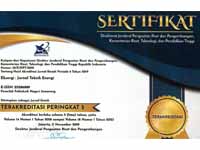Horizontal Axis Wind Turbine Efficiency Optimization Through Tip Radius Modification on 4:5 Flat Taper Blades
DOI:
https://doi.org/10.32497/eksergi.v21i03.7112Keywords:
edge modification, flat tapper, horizontal axis, performance, , wind turbineAbstract
This study aims to investigate how changing the roundness of the back edge of blades affects a 4:5 flat taper wind turbine. Tests used blades with 5 mm, 10 mm, and 15 mm rounded edges, compared to a 5 mm notched blade, across wind speeds from 3 to 9 m/s. The results show the 5 mm rounded edge works best at low wind speeds, with an efficiency of 11.12% at 3 m/s. At higher wind velocities, the 15 mm rounded blade demonstrated superior aerodynamic performance, attaining an efficiency of 1.63% at 7 m/s. The rounded trailing edge improved aerodynamic behavior by minimizing turbulence and enhancing flow stability. Therefore, the optimal edge radius should be determined based on regional wind characteristics, especially for low-speed wind zones typical of Indonesia
References
[1] K. ESDM, “Hingga 2030, Pemerintah Bidik Tambahan Kapasitas Terpasang PLTB 5 GW,” 2024. https://ebtke.esdm.go.id/artikel/siaran-pers/hingga-2030,-pemerintah-bidik-tambahan-kapasitas-terpasang-pltb-5-gw
[2] S. T. Mesin, F. Teknik, U. N. Surabaya, J. T. Mesin, F. Teknik, and U. N. Surabaya, “TERHADAP KINERJA TURBIN ALIRAN VORTEX Rizki Ari Pradana Priyo Heru Adiwibowo Abstrak,” pp. 17–26, 2010, [Online]. Available: https://ejournal.unesa.ac.id/index.php/jtm-unesa/article/view/31558
[3] Fabiean Baihaqi Ma’aruf, “Analisis karakteristik turbin angin sumbu horizontal 2 sudu 300w 12v di pantai puger,” pp. 1–35, 2018, [Online]. Available: https://repository.unej.ac.id/bitstream/handle/123456789/87001/Fabiean Baihaqi Ma’aruf-141910201066.pdf?sequence=1&isAllowed=y
[4] M. R. Fachri and H. Hendrayana, “Analisa Potensi Energi Angin dengan Distribusi Weibull Untuk Pembangkit Listrik Tenaga Bayu (PLTB) Banda Aceh,” CIRCUIT J. Ilm. Pendidik. Tek. Elektro, vol. 1, no. 1, pp. 1–8, 2017, doi: 10.22373/crc.v1i1.1377.
[5] Y. D. Herlambang, D. Hendrawati, A. D. Agustin, K. A. Kusuma, S. Wahyuningsih, and W. Wigiantoro, “MODEL TURBIN ANGIN SAVONIUS UNTUK MENINGKATKAN KINERJA PLTB,” Eksergi, vol. 16, no. 1, p. 35, Dec. 2020, doi: 10.32497/eksergi.v16i1.2203.
[6] - Sahid and S. Priyoatmojo, “Rancang Bangun Turbin Angin Poros Horizontal Tiga Sudu Flat Berlapis Tiga Dengan Variasi Sudut Dan Posisi Sudu,” Eksergi, vol. 15, no. 1, p. 14, Jun. 2019, doi: 10.32497/eksergi.v15i1.1462.
[7] M. F. Alyasa, S. Sahid, M. Mulyono, T. Prasetyo, D. Hendrawati, and Y. M. Safarudin, “Turbin Angin Poros Horizontal Tipe Flat Sudu Banyak Taper 4:5 dan Sudut Keluaran 25°,” J. Rekayasa Mesin, vol. 17, no. 1, p. 169, May 2022, doi: 10.32497/jrm.v17i1.3086.
[8] F. Aryanto, M. Mara, and M. Nuarsa, “Pengaruh Kecepatan Angin Dan Variasi Jumlah Sudu Terhadap Unjuk Kerja Turbin Angin Poros Horizontal,” Din. Tek. Mesin, vol. 3, no. 1, pp. 50–59, 2013, doi: 10.29303/d.v3i1.88.
[9] Z. Zhang et al., “Comparative analysis of bent and basic winglets on performance improvement of horizontal axis wind turbines,” Energy, vol. 281, p. 128252, Oct. 2023, doi: 10.1016/j.energy.2023.128252.
[10] T. M. I. Ichwanul, T. S. Sinung, Ardanto, D. Herdiana, and A. Ariwibowo, “Studi Eksperimental Perangkat Ujung Sayap Pada Pesawat 19 Penumpang,” Teknol. Penerbangan, vol. 4, no. 01, pp. 22–27, 2020ESDM, “72F25-Web-Publish-Statistik-2022,” Stat. Ketenagalistrikan Pln, vol. 36, pp. 1–114, 2022.
Downloads
Published
Issue
Section
License
Copyright (c) 2025 Faranita Putri Anandia, Sahid Sahid, Christopher Johanes Edsel Wattimena, Okta Ayu Pratiwi, Riris Annisa Tarra Tantri, Muhammad Barid

This work is licensed under a Creative Commons Attribution 4.0 International License.
Authors who publish with this journal agree to the following terms:Authors retain copyright and grant the journal right of first publication with the work simultaneously licensed under a Creative Commons Attribution License that allows others to share the work with an acknowledgement of the work's authorship and initial publication in this journal.
Authors are able to enter into separate, additional contractual arrangements for the non-exclusive distribution of the journal's published version of the work (e.g., post it to an institutional repository or publish it in a book), with an acknowledgement of its initial publication in this journal.
Authors are permitted and encouraged to post their work online (e.g., in institutional repositories or on their website) prior to and during the submission process, as it can lead to productive exchanges, as well as earlier and greater citation of published work (See The Effect of Open Access).






